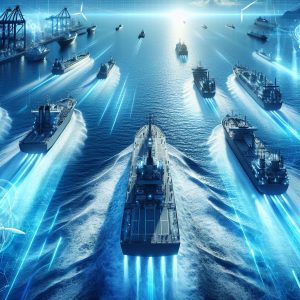Innovation in Navigation: EPS and the Silent-E Notation for Silent Sustainability
The global maritime sector has taken a significant step towards sustainability with the signing of a Memorandum of Understanding between Eastern Pacific Shipping (EPS), the classification society DNV, and the shipyard Hengli. This agreement, which will implement the Silent-E notation in a new series of 6,000 TEU container ships, represents a crucial commitment to reducing the ecological footprint of maritime transport. The Silent-E notation symbolizes that vessels are designed and built to effectively control underwater noise emissions, a form of oceanic pollution that negatively impacts marine ecosystems. By attenuating this noise, EPS’s new ships will support marine biodiversity, reflecting a strong commitment to sustainable navigation practices. For merchant navy professionals, this initiative not only signifies a step forward in protecting marine life but also reinforces adaptation to growing global regulatory expectations. It also presents new job opportunities in companies leading the shift towards greener and more responsible maritime transport.
Environmental Commitment: Marine Life
- EPS’s ecological approach is aligned with its ESG (Environmental, Social, and Governance) strategy and the United Nations Sustainable Development Goal 14, “Life Below Water.” This goal aims to conserve and sustainably use the oceans, seas, and marine resources. Reducing underwater noise is crucial to preserving communication, orientation, and other vital behaviors of cetaceans and fish.
- Flights that participate in these initiatives are better prepared to comply with emerging regulations and can benefit from port incentives in regions such as Canada and the US West Coast, which offer discounts on fees to vessels with low noise performance.
The Silent-E Notation: More Than a Certificate
- The Silent-E is a voluntary certification that confirms that a ship meets specific limits for low underwater noise emissions during its operations. This notation emphasizes environmental commitment and minimizing the impact on sensitive marine ecosystems.
- Underwater radiated noise (URN) is mainly produced by propeller cavitation and machinery vibrations. To achieve the Silent-E notation, vessels require specific design and construction measures to balance noise reduction with operational efficiency.
Technology in Support of Silence
- Effective reduction of underwater noise is achieved through techniques such as propeller optimization, which reduces cavitation by adjusting diameter, blade number, and wake input to decrease rotation speeds.
- Improvements in machinery insulation are crucial, reducing engine and generator vibrations through resilient mounts or low-vibration machinery configurations.
These advancements are not only vital for regulatory compliance but also enhance fuel efficiency and reduce mechanical wear, resulting in operational and economic benefits for shipowners.
Opportunities and Benefits for the Future
For maritime investors, EPS’s adoption of the Silent-E notation represents a strategic move towards a more sustainable and responsible future. This commitment not only enhances corporate reputation but also opens up new avenues for funding and collaboration with governmental and ecological entities. For nautical enthusiasts, these innovations represent an example of how technology can improve our interactions with the marine environment, encouraging a renewed respect for life beneath the waves and promoting a mindset shift towards more sustainable practices in all aspects of navigation. Finally, for merchant navy professionals, these initiatives provide fertile ground for the development of advanced technical skills and position crews as an integral part of a global effort to protect our planet, while providing job security in an ever-evolving sector.
EPS: Leadership in Sustainability
With 60 years of activity and headquartered in Singapore, EPS has established itself as a leader in maritime transportation committed to technological growth and environmentally responsible practices. Their fleet covers 31 million deadweight tons in segments such as containers, dry bulk, gas, and tanks. The company employs 7,000 maritime and office professionals, who form interdisciplinary teams to offer effective and sustainable navigation solutions worldwide. EPS is recognized for its innovative approach to fleet and operations management, positioning itself as a role model in the industry.
Looking Towards the Future: The Impact of Sustainable Innovations
The signing of this Memorandum of Understanding not only paves the way for a quieter and more environmentally friendly fleet but also reinforces the importance of strategic partnerships to promote positive change in global maritime transport. By adopting standards like the Silent-E, companies can anticipate future regulations and take advantage of economic incentives offered by various jurisdictions worldwide that value sustainability in their waters. This initiative underscores the need for a collaborative approach in maritime technology, bringing together shipbuilders, classification societies, and shipowners to create a lasting impact on our oceans and ensure a legacy of environmental responsibility for future generations.





